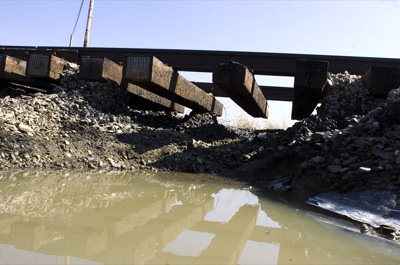Thursday, March 3rd, 2011
Mitigation for the Reservoir Mill begins
By Amy Kronenberger
ST. MARYS - City officials on Wednesday prepared for the possibility of tearing down the Reservoir Mill on High Street, even as they continue to look at options to save it.
Current plans call for the demolition of the mill before two deteriorating bridges on High Street - one spans the canal adjacent to the mill, the other spans the millrace - can be replaced. But, because the 163-year-old mill is eligible for the National Register of Historic Places, the city also must try to find an alternative.
If no suitable alternative is found, the city must provide mitigation to preserve its memory. Local historians at the meeting Wednesday were not happy with suggestions on how to get that accomplished.
To keep the project moving on schedule, the city is moving forward with mitigation to prepare for its demolition while they wait for test results of two possible alternatives.
When the project first began almost three years ago, engineers said all the best options involved pile driving the earth around the crumbling foundation of the mill. This created too great a risk of collapse, requiring demolition, city engineer Craig Moeller said in the mitigation meeting Wednesday afternoon with St. Marys, Ohio Department of Transportation (ODOT) and historical preservation officials.
The city prefers the option of a single-span bridge because this will allow a walk path under the bridge on the canal tow-path and will allow the city easier access to sewer, water and gas lines. The single-span bridge also would provide security for better flood control, as the city learned Monday, Moeller said.
The two alternatives being reviewed that would not require mill demolition are a Con/Span bridge and a drilled shaft bridge.
Moeller said a drilled shaft bridge involves drilling down into the bedrock, sleeving the hole and filling it with concrete. A Con/Span bridge is made from a company who makes prefabricated concrete spans and installs the bridge.
Both options minimize vibrations and pile driving, which would save the mill, Moeller said. However, these options would be more expensive. The city is doing soil testing for these options and will know in about two months if either will work.
Sleeving and grouting the existing bridge is not an option because it would take away the walk path and access to the utility lines, Moeller added.
Mary Ann Olding, a consulting party in favor of saving the mill, asked why these options were not explored in the beginning.
"Why are these options only just surfacing?" Olding asked. "If these alternatives were explored in the beginning, a lot of time and money would have been saved for everyone."
Moeller said the options were not considered in the beginning because the engineers found pile driving to be the best alternative. The building was not eligible for the national register at that time, so they did not look into other alternatives, he said.
Rick VanLandingham, another consulting party interested in saving the mill, said if ODOT was doing its job correctly, the mill would have been placed on the national register right away, instead of a year later.
ODOT originally said the mill was not eligible because officials thought it wasn't old enough and that it had been altered too much over the years. When an Auglaize County Historical Society member sent ODOT more information, the investigation was reopened and the building was made eligible.
"The information showing that it is eligible seems to be readily available public information and shouldn't have needed a private citizen to say 'hey wait a minute, the information is right here,'" VanLandingham said. "If ODOT had been a bit more diligent in discovering what was readily available information, then perhaps eligibility would have been determined a little earlier."
ODOT official Tim Hill said the process is dynamic. Because they are not from the area, they don't always have access to all the information. Therefore, they rely on locals coming forward.
"We could have been hard-nosed and said 'no we've made our decision. We're moving forward no matter what you send us,' " Hill said. "Instead, when they sent the information to us, we said 'you're right,' and we re-evaluated the situation."
When discussing mitigation of the mill, ODOT provided a short list of possibilities, including documenting the mill's history, plaques and educational kiosks.
Olding said she was not happy with ODOT's suggestions.
"In no way do any of these suggestions equal the importance of this building," she said. "These examples are weak."
Nancy Campbell, architecture transportation reviews manager of the Ohio Historic Preservation Office (OHPO) in Columbus, asked Olding what ideas she had to preserve the memory. Olding said she would rather focus her time and money on saving the mill.
VanLandingham gave the idea of saving a portion of the foundation to reopen the water system with a working wheel. This would educate people how the mill used to operate. Other ideas put forward were a book and multiple sign posts for people walking the path or canoeing the canal.
Safety Service Director Tom Hitchcock asked what would happen to the mill if it weren't torn down and owner Jim Heinrich reverted it back to the state. What would the state do with it? he asked.
Steve Dorsten of the Ohio Department of Natural Resources, which owns the land on which the mill sits, said the state wouldn't want the mill. But if they got it, they would be willing to partner with interested parties to fix it up.
The fate of the mill will be decided in about two months. If it is demolished, the project will cost $1.2 to $1.4 million with federal funds covering up to $1 million. If one of the alternatives are approved, that cost will go up. Either way, the project will not begin until 2013 or 2014, Moeller said.




